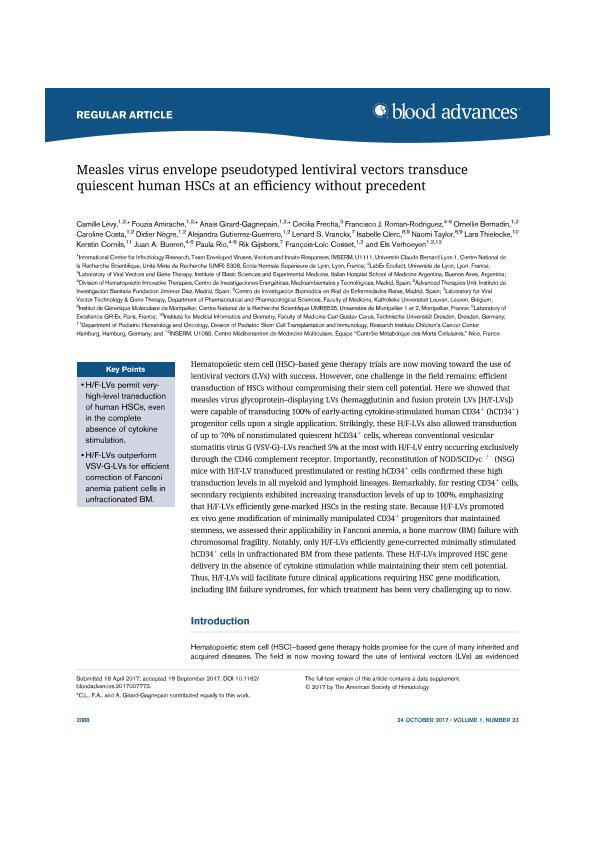Artículo
Measles virus envelope pseudotyped lentiviral vectors transduce quiescent human HSCs at an efficiency without precedent
Lévy, Camille; Amirache, Fouzia; Girard Gagnepain, Anais; Frecha, Cecilia Ariana ; Roman Rodríguez, Francisco J.; Bernadin, Ornellie; Costa, Caroline; Nègre, Didier; Gutierrez Guerrero, Alejandra; Vranckx, Lenard S.; Clerc, Isabelle; Taylor, Naomi; Thielecke, Lars; Cornils, Kerstin; Bueren, Juan A.; Rio, Paula; Gijsbers, Rik; Cosset, François Loïc; Verhoeyen, Els
; Roman Rodríguez, Francisco J.; Bernadin, Ornellie; Costa, Caroline; Nègre, Didier; Gutierrez Guerrero, Alejandra; Vranckx, Lenard S.; Clerc, Isabelle; Taylor, Naomi; Thielecke, Lars; Cornils, Kerstin; Bueren, Juan A.; Rio, Paula; Gijsbers, Rik; Cosset, François Loïc; Verhoeyen, Els
 ; Roman Rodríguez, Francisco J.; Bernadin, Ornellie; Costa, Caroline; Nègre, Didier; Gutierrez Guerrero, Alejandra; Vranckx, Lenard S.; Clerc, Isabelle; Taylor, Naomi; Thielecke, Lars; Cornils, Kerstin; Bueren, Juan A.; Rio, Paula; Gijsbers, Rik; Cosset, François Loïc; Verhoeyen, Els
; Roman Rodríguez, Francisco J.; Bernadin, Ornellie; Costa, Caroline; Nègre, Didier; Gutierrez Guerrero, Alejandra; Vranckx, Lenard S.; Clerc, Isabelle; Taylor, Naomi; Thielecke, Lars; Cornils, Kerstin; Bueren, Juan A.; Rio, Paula; Gijsbers, Rik; Cosset, François Loïc; Verhoeyen, Els
Fecha de publicación:
10/2017
Editorial:
American Society of Hematology
Revista:
Blood Advances
ISSN:
2473-9537
Idioma:
Inglés
Tipo de recurso:
Artículo publicado
Clasificación temática:
Resumen
Hematopoietic stem cell (HSC)–based gene therapy trials are now moving toward the use of lentiviral vectors (LVs) with success. However, one challenge in the field remains: efficient transduction of HSCs without compromising their stem cell potential. Here we showed that measles virus glycoprotein–displaying LVs (hemagglutinin and fusion protein LVs [H/F-LVs]) were capable of transducing 100% of early-acting cytokine-stimulated human CD34+ (hCD34+) progenitor cells upon a single application. Strikingly, these H/F-LVs also allowed transduction of up to 70% of nonstimulated quiescent hCD34+ cells, whereas conventional vesicular stomatitis virus G (VSV-G)–LVs reached 5% at the most with H/F-LV entry occurring exclusively through the CD46 complement receptor. Importantly, reconstitution of NOD/SCIDγc−/− (NSG) mice with H/F-LV transduced prestimulated or resting hCD34+ cells confirmed these high transduction levels in all myeloid and lymphoid lineages. Remarkably, for resting CD34+ cells, secondary recipients exhibited increasing transduction levels of up to 100%, emphasizing that H/F-LVs efficiently gene-marked HSCs in the resting state. Because H/F-LVs promoted ex vivo gene modification of minimally manipulated CD34+ progenitors that maintained stemness, we assessed their applicability in Fanconi anemia, a bone marrow (BM) failure with chromosomal fragility. Notably, only H/F-LVs efficiently gene-corrected minimally stimulated hCD34+ cells in unfractionated BM from these patients. These H/F-LVs improved HSC gene delivery in the absence of cytokine stimulation while maintaining their stem cell potential. Thus, H/F-LVs will facilitate future clinical applications requiring HSC gene modification, including BM failure syndromes, for which treatment has been very challenging up to now.
Palabras clave:
Genetherapy
,
Lentiviral Vectors
,
Pseudotype
,
Raga Mice
Archivos asociados
Licencia
Identificadores
Colecciones
Articulos(SEDE CENTRAL)
Articulos de SEDE CENTRAL
Articulos de SEDE CENTRAL
Citación
Lévy, Camille; Amirache, Fouzia; Girard Gagnepain, Anais; Frecha, Cecilia Ariana; Roman Rodríguez, Francisco J.; et al.; Measles virus envelope pseudotyped lentiviral vectors transduce quiescent human HSCs at an efficiency without precedent; American Society of Hematology; Blood Advances; 1; 23; 10-2017; 2088-2104
Compartir
Altmétricas



